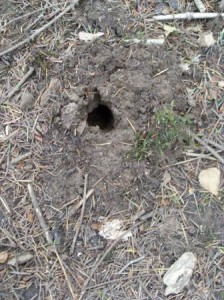Who could live in a house like this?
A small hole in the ground could be the entrance to the home of one of many different types of small mammal. There are a few clues though, that can give us an idea of who the occupant might be.
Many mice species can be ruled out, as dormice and harvest mice make nests above ground. Mole earthworks are characterised by much larger mounds of earth, typically in a line.
A water vole is much too big to fit in to this hole, which was about the size of a 50 pence piece. Also their homes would be found by the water’s edge, where as this was on a path way above the river.

Rats, stoats and weasels all tend to build their homes in covered ground, where they can slink in and out of hiding easily. This hole is right out in the open on a bare path, which is actually typical of the wood mouse.
The tunnel system of a wood mouse house can actually reach depths of 1 meter, with one large nest chamber filled with finely shredded grass connected to the tunnel. A small conical mound like this is a typical sign of wood mouse excavation and the size of the hole fits the wood mouse perfectly. In summer, however, wood mice may sleep above ground, but it is unlikely they have had much chance for that this year
Check out the ‘woodland wanderer’ blog to see a picture of one of these cute critters, or watch the YouTube link on ‘otter or other’ to see these little jumping beans in action.
Bye for now,
Rhian (Seasonal Ranger)
Help protect Scotland’s wildlife
Our work to save Scotland’s wildlife is made possible thanks to the generosity of our members and supporters.
Join today from just £3 a month to help protect the species you love.
Preface
A small hole in the ground could be the entrance to the home of one of many different types of small mammal. There are a few clues though, that can …
